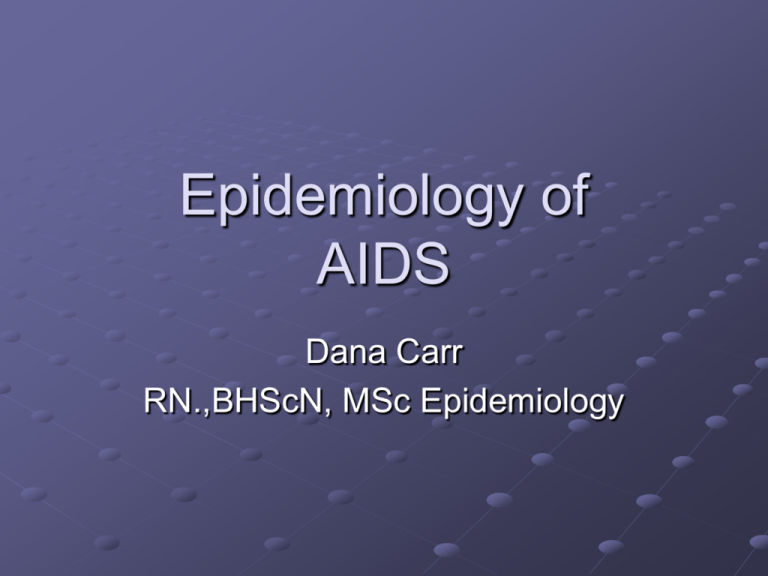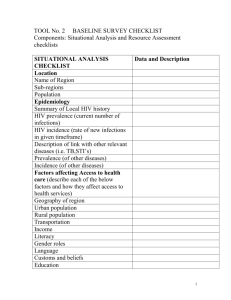
Epidemiology of
AIDS
Dana Carr
RN.,BHScN, MSc Epidemiology
Outline
HIV virology
Epidemiology
Compare rates in Africa and NA.
Compare modes of transmission
Dry Sex and I TRACK
Human Immunodeficiency
HIV
Retro Virus (RNA)
Subgroup Lentvirus (slow)
Inert
Fragile
Protective envelope
Attacks immune system
Invades Helper T cell lymphocytes and
macrophages (WBC)
gp120 molecule attaches to the CD4 molecule
on the T helper and macro
HIV Virus
Helper T cell the virus enters the nucleus
of the WBC
uses the DNA coding to replicate;
T helper cells are destroyed releasing
virus
HIV virus entering macrophages replicate
and them bud out of an intact cells.
HIV Budding from macrophage
HIV virus attacking T helper cell
HIV the infectious agent
Incubation period –variable 1-15 yrs w/o tx
Transmission- sexual contact (increased
risk with ulcerative STD’s , anal), sharing
contaminated needles, transfusion,
Reservoir – Human BBF
Communicability – unknown presumed
early onset extends through life
Symptoms – opportunistic
infection,ARC,AIDS
HIV to AIDS
Global transmission of HIV
What’s in a Name?
Definition of Epidemiology
‘epi’ upon ‘demos’ people ‘logos’- study of
The study of what befalls a people (not the
individual)
Oxford Dictionary 1873 “branch of medical
Science which treats epidemics”
“epidemic’ related to disease (communicable)
Epidemiology 2002
“ the study of the distribution and determinants
of health-related states or events in specified
populations, and the application of this study to
the control of health problems”
Study – surveillance, observation, research
Distribution ‘ person, place time
Determinants – biological, behavioral, physical, social and cultural
Health related states or events – disease; wellness; behaviors
Specified populations- characteristics
Control of Health – prevention and promotion
Principles of Epidemiology
Basic science of public
health
Health and disease do
not occur randomly in a
population
What is the probability of
the event occuring and
‘who is at risk?’
Good research methods
‘garbage in ..garbage out’
Exposures and outcomes
Probability of event
occuring (rate)
Comparing (rates) in
different populations or
the same population at
different times
Hypothesize why they are
different
Models of disease Transmission
Epidemiological TRIAD
Host
Intrinsic factors that influence host susceptibility
Environment
Extrinsic factors
Opportunity for infection to occur
Agent
Biological characteristic of agent
Triad Cont’d - Determinants
Agent factors: pathogenicity; virulence
Host factors: age, gender; education;
behaviors; culture
Environmental: climate; geography;
biological; socioeconomic, political
Models of Disease
‘Web of Causation’
Metaphor for the complex, multifactoral
causation of disease
communicable and non-communicable
Types of Studies
Descriptive (leads to hypothesis development)
Case study (one unusual case)
Case series
Survey - cross sectional
Analytical Studies (hypothesis testing)
Cohort – compare # case in exposed and unexposed groups
Case- control - compare exposures in cases and non cases
Ecological Studies – study exposure and outcomes in
groups or populations (not individuals) eg Selenium and
HIV
Incidence vs prevalence
Incidence –the number of NEW
events/cases during a given period of time
in a specified population (temporal)
Prevalence – the number of events/cases
at a designated time in a specified
population (snapshot)
Rates….Why use them?
Rate =
the # of events in a specified period
population at risk during that time
Rates are proportions
Proportions can be compared
Compare rates of events in different
populations and hypothesis why they are
different.
Living with HIV infection
Sub Sahara Africa Vs North America
Sub sahara Africa
25.4 million
Adult Prevalence 7.4%
HIV1& HIV2
Mode of Transmission
HETEROSEXUAL 70 90 % new cases
Vertical (mom to baby)
Life expectancy –
short 1-3 yrs (no tx)
North America
1.0 million
Adult Prevalence 0.3
HIV1
Mode of Transmission
MSM (58%)
IDU (20%)
Life expectancy15-20 with tx
Think about
Triad: host; agent ; environment and how
they relate to HIV
To what extent does culture ie values
beliefs; influence the spread of HIV
How does culture impact prevention and
control programs
London School of Hygiene and Tropical Medicine (LSHTM)
Multicentre Study on Factors
Determining Differential Spread of HIV in 4 Cities
in Sub Sahara Africa
change in HIV prevalence among pregnant women
during 10 year period (mid 80’s to mid 90’s)
Cotonou (Benin) 0-0.6%
Yaounde (Cameroon) 1 – 5.5%
Kisumu (Kenya) ? – 25 %
Ndola (Zambia) <5 – 25 %
HIV transmission in Sub-sahara
Africa
10% world population
2/3 of all people living with HIV
Predominantly heterosexual transmission
– Estimate 70 to 90% all new cases
Vertical Transmission
Factors that increase probability of
Transmission of HIV
1. Biological – increase viral load, genital ulceration
resulting from STD’s (HSV2) , dry sex practice; sex
during menses; anal sex ; lack of circumcision
2. Behavioral - Sexual partners (consecutive,
concurrent); rate of partner change; contact with
STW; anal sex; lack of Circumcision; dry sex
Think about the overlap of cultural and biological risk
factors
Comparison of Prevalence of HIV
during 10 yr period
1997 1998
%Males %15-19
yrs
%
Females
%14 – 19
yrs
%
practice
dry sex
Cotonou
3.3
3.4
3.2
Yaounde
4
7.8
4.5
Kisumu
20
3.5
30.1
23.0
2.2
Ndola
23.2
3.7
31.9
15.4
14.7
Multi centre study Methodology
Cross sectional survey
Sample population in each city:
– Males 600 to 900
– Females approx 1000
Questionaire interview
– Sociodemographic
– Sexual behaviors
Specimen collection and phys. examination
– Biological RF
Risk Factors Consistently more common in the high
HIV prevalence Sites
Parameters of Sexual Behavior
young age at first sexual encounter (female)
Young age at first marriage
Large age difference between spouses
Co factors in HIV transmission:
HSV- 2 infection
Trichomoniasis (females)
Lack of male circumcision
Risk Factors NOT Consistently more common in the
high HIV prevalence Sites
Parameters of sexual behavior
High rate of partner change
Sex with sex workers
Concurrent partnerships
Large age difference between non spousal
partners
Co- factors in HIV transmission
Non-ulcerative STI’s (gono, chlamydia)
Syphilis
Dry sex
Lack of condom use
Everything you wanted to know
about Dry Sex…..
Documented in 11 countries in sub-Sahara
Africa
The practice of Dry Sex is the use of
substances to dry the vagina prior to
intercourse
‘Love Medicine’ women use to please men
Methods
Ingestion - tea or porridge
Insertion – mixed with saliva or cloth
Wiping – cloth or finger
Juju belt – herbs worn around waist
Body smearing substances
Substances used for Dry Sex
Plants: Leaves (cassava, tomatoe); Bark;
roots; herbs,
commercial products (soap,detergent salt,
toothpaste,vicks)
stones (crushed or powdered)
animal products
Cloth; tissue
icecubes
Culture of Dry sex
Men prefer dry vagina; increase sensation;
secretions not desirable;
Women often economically dependant on
men
Marital fidelity and stability
Taught to young girls as rites of passage
by elders
13 andn 14yr olds pressured by older men
to be sexually active
Dry sex as a RF for HIV
transmission
Biological : direct or indirect injury to vaginal wall;
facilitate transmission of HIV from infected male to
susceptible female
–
–
–
–
–
Portal of entry for HIV
Increase WBC at site ; viral reservoir
Decrease lactobacillus increase risk of HIV transmission
Dry sex deterrent to condom use
Condom breakage due to heat and dryness
Faciltates transmission of virus from infected female to
susceptible male ( lower viral load; increase shedding)
Characteristics of Women who
practice dry Sex in Ndola, Zambia
35.4% of women in study ingested substances
(only 15 practiced insertion)
Frequency of practice increased with age
Women who were married were more likely to
practice dry sex
Only 5.4 % of all women who practiced dry sex
used condoms
35% HIV positve; not significantly assoc with
ingestion of substances for dry sex ;
Sample size for insertion too small
Do NA women practice a form of
dry sex??
Douching for example
What else do we do?
– Piercing?
– Tattooing
Impact of culture in Transmission
and prevention.
Dry sex is embedded in their culture
Is discontinuing practice an option?
Condom negates effect of dry sex
What are some options??
Canada Estimates 2002
Adult Prevalence (15-49) 0.3%
Total cases: 56,000 (46,000 to 66,000)
HIV
Heterosexual 10,000 (18%)
High Risk Groups:
MSM- 32,500 (58%)
IDU –11,000 (20%)
Aboriginal - 509 (3.1%)
Estimated exposure category distributions (%) among new
HIV infections by time period
(PHAC HIV/AIDS Epi Update- May 2004)
80
70
60
1981-1983
1984-86
1987-90
1996
1999
2002
50
40
30
20
10
0
MSM
IDU
Hetero
Aboriginal Population
Aboriginal: only represent 3.3 % of the
Canadian population but represent 3.1%
of the reported HIV cases. (14.4 % all
AIDS case)
over represented in HIV epidemic
IDU key mode of Transmission
Significant impact on Aboriginal women
Infected at younger age than nonAboriginal
Aboriginal HIV/AIDS Stats
MSM
Risk Behaviors
unprotected anal sex with casual or regular
partners
Unsafe sex practice with known HIV –
positive partner
Injecting Drug Users
Hi Risk Behaviors
Sharing needles
Sharing equipment
Trading unprotected sex for money and
Drugs
incarceration
Enhanced Surveillance of
Hi Risk Groups
Prevalence of HIV/AIDS in the general
population low and these numbers don’t
reflect the prevalence in hi risk groups
enhanced surveillance of high risk groups
is required to monitor trends in behaviors
and disease
Better able to target prevention and
control measures
North America:I TRACK
survey
Prevalence low in general population
High risk groups MSM , IDU, Aborginal
Enhanced surveillance in hi risk groups
Target prevention meaures
Consider the ‘cultural issue of IDU; MSM
and aboriginal
I TRACK Survey 2002
Enhanced surveillance of HIV/Hep C
Risk Behaviors among Injecting Drug
users in Canada
Multi site surveillance Victoria, Regina,
Sudbury, Toronto
I TRACK Survey
4 sites – Victoria, Sudbury, Regina,
Toronto
‘questionaire/interview- determinants;
behaviors
Blood sample – HIV/HEP C outcome
Victoria Data/Results
Estimate Population IDU – 1500 -3000
(RARE study)
I TRACK study population – 150
recruited from needle exchange
HIV prevalence – 16%
Hep C – 79.3 %
Co infection 16% (all HIV + were HepC+)
Sociodemographic
Gender:
Male 70.7%
Female 29.3%
Ethnicity
Aboriginal 20%
Caucasian 32.7%
Other 47.3%
Mean Age:
Male 37.8
Female 32.8
Education
Completed College/univ –
12.7%
Some Coll/Un – 19.3%
SSGD – 22%
Some HS – 46.0 %
Injection Behavior
Substances injected
Cocaine 92.7%
Heroin 73.3 %
Dilaudid 50%
Morphine 46.7%
Frequency of
Injection
Everyday 44%
At least 1/wk 36%
Not every wk 17.3
Hi Risk Behavior
equipment use past
6mos
Used Syringes 30.7%
Used Equip 48 %
Never use Condom
for penetrative sex
Women
Regular partner 81.5%
Casual 22.2%
Client 0 %
Men
Regular partner 64 %
Casual 19%
Client 0%
The Culture of Injecting
Drugs
Intimacy
Illegality
Bonding
Value and beliefs



